
Oneida Lake is named after an Iroquois tribe that once lived around the lake. This water feature has a maximum depth of 55 ft (17 m) and an overall surface area of around 50,000 acres (20,000 hectares). Access points near I-81, at Toad Harbor, and the Cleveland Docks provide boat access to the lake. In addition, there are picnic areas, parking spaces, piers, and public restrooms at some access points.
Aside from traditional recreational activities like hiking, bird watching, and picnics, Oneida Lake is home to several bass fishing tournaments. Here, anglers can test their skills by catching impressive black and white basses. Additionally, Oneida Lake is one of the premier locations for sourcing walleye eggs for sportfish stocking in New York. This resource contains current fishing regulations.
Oneida Lake has been troubled by the invasive zebra mussel (Dreissena polymorpha), an infamous non-native mussel found in the Great Lakes and connected waters. Introduced initially through ship ballast water, the zebra mussel has spread throughout the region. Its rapid growth rate and small size allow it to colonize any solid structure, eventually covering them completely. This can threaten aquatic infrastructure as zebra mussels quickly colonize pipes, clogging them with cement-like mussel colonies. Interestingly, some regions benefit from zebra mussel’s introduction. For example, zebra mussels have improved the water clarity in Oneida Lake, allowing more vegetation to grow.
Oneida Lake Fish Species
1) Yellow perch (Perca flavescens)
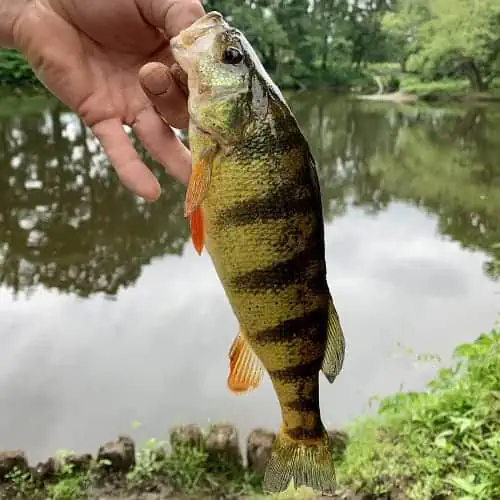
Yellow perch are one of the most sought-after sportfish at Oneida Lake. Not only are they fished throughout the warmer months, but they can also be caught when the lake freezes via ice fishing. In addition, this small yet trendy sport fish is a great-tasting Great Lakes native. Luckily, they occur in large schools, so they can be caught in abundance despite their small size, which maxes out at 4 pounds (1.8 kg) and 14 inches (35.6 cm). Additionally, their abundance and small size make them an important food source for predators, including giant sunfish and birds. As a result, young yellow perch are a critical food source for larger predator fish.
The native range of the yellow perch extends as far south as Louisiana and north into Canada. Therefore, it can be found throughout most of Canada and the northeastern United States. This species prefers lakes and avoids extremely cold or warm weather. In addition, they are tolerant of hypoxic (low oxygen) conditions.
The yellow perch consumes invertebrates and small fish. They occur in freshwater and brackish water and can tolerate a variety of habitats. They typically spawn from April to May when the waters are warm. In their introduced range, they often eat native fish and compete with them for food which places pressure on native fish populations.
The fishing season for yellow perch is open year-round in New York, and anglers may catch up to 50 fish per day.
2) Walleye (Sander vitreus)
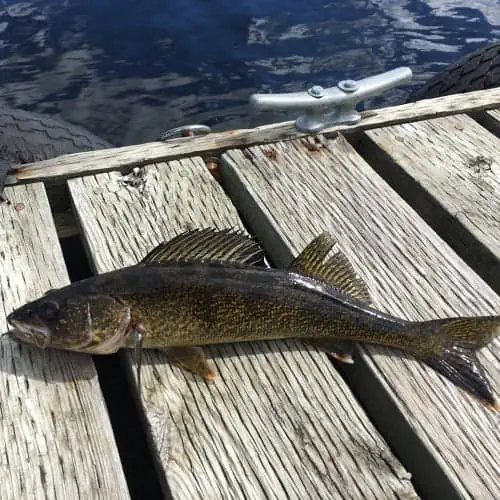
The walleye, not to be confused with the oceanic walleye pollock (Gadus chalcogrammus), is an extremely important commercial and sportfish. At Oneida Lake, they are among the most popular fish available during the summer for typical deep-water fishing and in the winter during the ice fishing season. Thanks to their large eyes, they are well adapted to their nocturnal lifestyle and visual hunting strategy. They also possess an arsenal of sharp teeth, facilitating their carnivorous diet. Walleyes are primarily piscivorous but are known to eat invertebrates, amphibians, and even small mammals.
During the spring, walleye are usually located in the shallow areas of Oneida Lake, and during the summer, they can be found in deeper waters. Up-to-date information on the walleye fishing season can be found here. This delicious fish is highly sought after by sport fishers. Fishing for walleyes is like fishing for bass species; they can be caught with various fishing tactics. Sources suggest using live bait such as minnows, earthworms, and leeches.
From 2022 to 2023 the fishing season for walleye at Oneida Lake runs from May 7th, 2022, to March 5th, 2023. Check the local wildlife agency for Information about the current year. Anglers may fish up to 3 walleye from Lake Oneida daily; only one fish can be over 14 inches (36 cm) long.
3) Fantail darter (Etheostoma flabellare)

Fantail darters are native to the eastern half of the United States and Canada. They are tolerant of various water conditions and are common throughout their range. Fantail darters prefer small or medium rivers, creeks, and streams with rocky substrates and ample objects to perch on and nest under.
This species is not as vibrantly colored as other Etheostoma species like the orangethroat darter (E. spectabile) or rainbow darter (E. caeruleum). Instead, they are usually tan or brown with vertical bars or spots, although some individuals lack these markings. Breeding males develop an orange tint on their fins. On average, this species is only around 2 inches (5 cm) in length.
Males find nesting sites underneath large objects like stones or submerged debris during breeding. A breeding pair will mate upside-down. Females then deposit around 45 eggs on the bottom of suitable stones. After mating, male fantail darters will guard their fry until they hatch.
4) Tessellated darter (Etheostoma olmstedi)
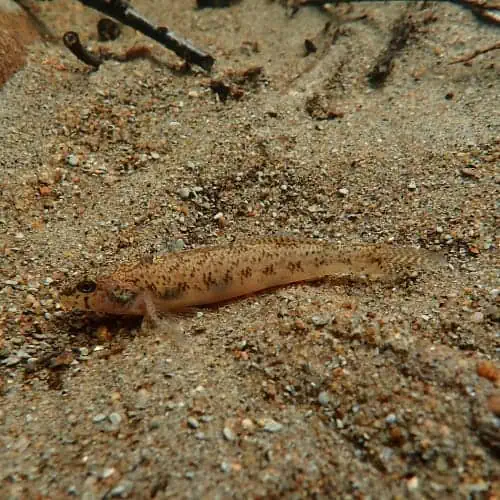
Tessellated darters can be found throughout New York and are native to states along the east coast from Florida to eastern Canada. They can be found in creeks and rivers with delicate substrates like sand or mud, within which they bury themselves to hide from predators. The diet of tessellated darters consists primarily of fly and caddisfly larvae.
Like the fantail darter, tessellated darters are not as vibrantly colored as other darters. They are typically brown with a mottled appearance and light underbellies. There are several forms in New York, with distinct markings and scaling patterns. Instead of developing vibrant orange and blue colors, male tessellated darters turn dark brown during the breeding season.
Generally, tessellated darters (or any darter, for that matter) are of little concern to anglers.
5) Bluegill (Lepomis macrochirus)

Bluegills are popular panfish with brown bodies and fins tipped with blue and orange. Males are more colorful than females. Historically, they were extremely popular, like the largemouth and smallmouth bass but are no longer routinely stocked on their own. However, they are suitable to stock alongside those larger species as a food source.
Bluegills primarily consume insects and only occasionally eat other small fish. As a result, they bioaccumulate fewer toxic metals and can be safer to eat. Spawning occurs in warm water between May and July. The male will construct and guard a nest throughout the season until the eggs hatch. Male bluegills tend to be particularly aggressive during the breeding season, and while they are not dangerous, they will try to attack swimmers if they come too close to the nest.
In New York, the bag limit for all sunfish is 50 per day.
6) Pumpkinseed (Lepomis gibbosus)

This round and beautiful sunfish sports an iridescent blue and orange coloration. Also known as just “pumpkinseed,” they are native to the northeastern United States. Like most non-native sunfish, they are introduced intentionally as sportfish and have also been introduced illegally. However, pumpkinseeds are native to New York and are particularly fun for kids to catch because they are visually striking and easy to fish.
This sunfish is smaller than the smallmouth and largemouth bass, with a maximum length of 15 inches (38 cm) and an average length of 3 inches (7.62 cm). They almost exclusively consume invertebrates and snails. In areas where they are introduced, they adversely affect invertebrate populations and readily hybridize with other sunfish.
Pumpkinseed spawn in the spring and the summer. First, like the largemouth and smallmouth basses, the males will construct and guard a nest. Then, over the next 3 – 5 days, the male will tirelessly protect and care for the eggs until they hatch.
In New York, the bag limit for all sunfish is 50 per day.
7) Black crappie (Pomoxis nigromaculatus)
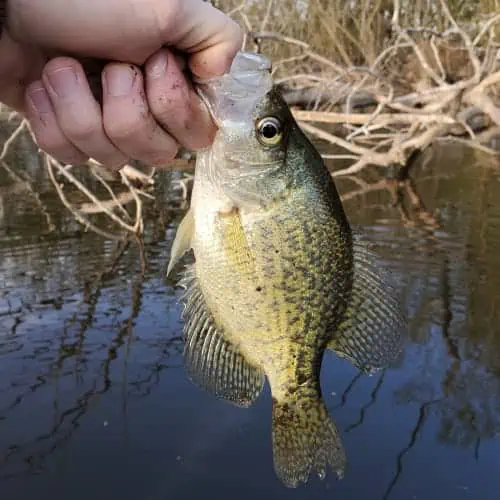
Black crappies are small, dark-colored sunfish with a mottled pattern. They are prevalent among anglers and are stocked frequently as sportfish throughout the United States. The mouth of a black crappie is also curved upward. On average, black crappies reach around 10.8 inches (27.4 cm) and can live up to fifteen years.
This species reaches sexual maturity at between 2 and 4 years of age. The breeding season for black crappies runs from the spring to the summer and is dependent on water temperature, with warmer water temperatures encouraging breeding. At this time, males will construct nests and breed with multiple females. A single female will lay eggs in various male nests producing around forty thousand eggs each season.
Black crappies tend to avoid the bottom of the water column, so bobbers or floating rigs work best. Black crappies hunt in schools in the open water for crustaceans and small fish, with their prey items increasing as they grow, so more are bound to be present when an angler finds one. They will accept a variety of baits and the best way to target black crappies is to fish near vegetation or submerged woody debris. In New York, an angler may harvest up to 25 crappies per day, provided they are over 9 inches (23 cm) in length.
8) Common carp (Cyprinus carpio)
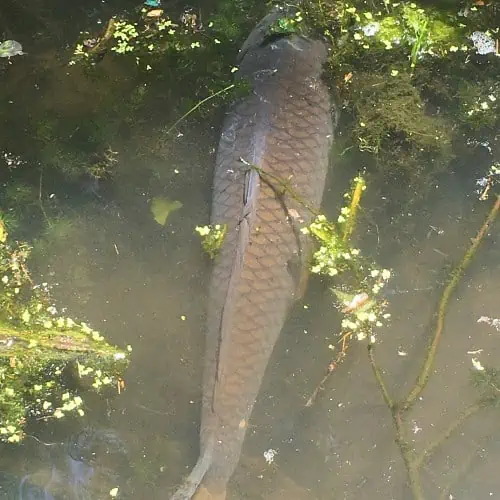
The European carp is a prolific invader introduced to the United States. This species is omnivorous, consuming both plants and small invertebrates. In search of food, it digs up gravel beds and uproots native plants, converting otherwise clear streams into murky messes that are unsuitable habitats for many native species. Habitat conversion disrupts local ecosystems by destroying habitats and eliminating food sources for native species. In addition to being an ecological nuisance, the European carp is considered a sportfishing pest.
European carp are tough to eradicate once they become established, which is another reason they are such prolific invaders. Once established, populations of European carp can be eradicated via rotenone applications. Rotenone is toxic to fish and can eliminate all fish in water. That water body is then restocked, now free of any nuisance species. However, this process is not ideal because it removes even the native fish from the ecosystem.
There is no limit on carp at Oneida Lake.
9) Rock bass (Ambloplites rupestris)
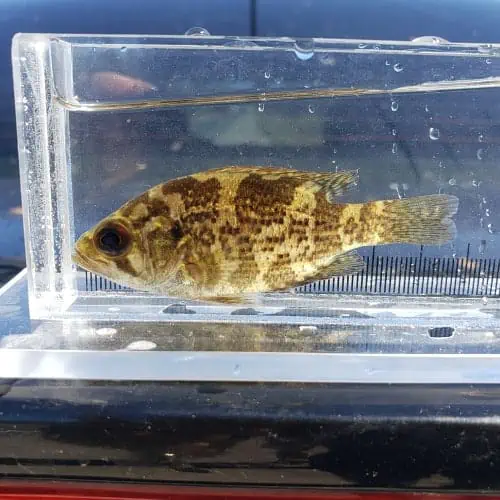
Rock bass are not considered temperate bass (Moronidae) nor black bass (sunfishes in the genus Micropterus). Instead, the rock bass is the type species for the genus Ambloplites, collectively called the rock basses. They are a type of sunfish and therefore share characteristics with black basses. Rock bass are a dull green or brown color; they usually have striking red eyes that help distinguish them from other species. If you count the spines on their anal fins, they should have six.
This species is not as common as other large sunfish species. It prefers clear water with loose gravel substrates and patchy, but not dense, vegetation. As is typical with sunfish, males construct a nest in the substrate, and females leave their adhesive eggs for them to care for and protect. Rock bass are non-native to Oneida Lake and were likely intentionally introduced for sportfishing.
Their diet includes insects, fish, and aquatic invertebrates like crayfish. They can change their color within a limited range from silver to dark gray to camouflage themselves.
There is no limit on rock bass at Oneida Lake.
10) Brown bullhead (Ameiurus nebulosus)
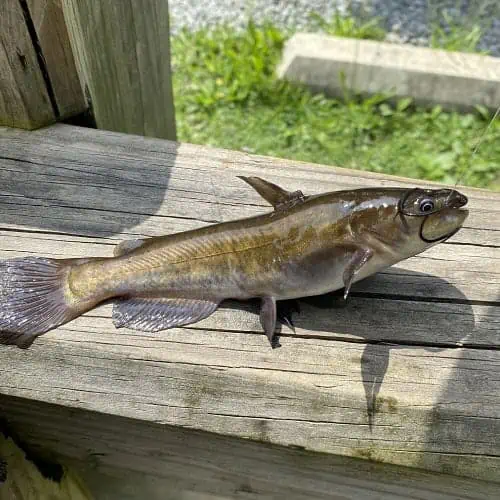
The brown bullhead is another small bullhead, approximately 9.8 inches (25 cm) in length, and has a superficially similar appearance to the yellow and black bullheads but possesses a mottled pattern toward the caudal fin. There are also spots on its fins. All barbels on a brown bullhead are dusky or dark colored. Another distinguishing characteristic is the presence of saw-like teeth on the rear edge of their pectoral spines.
This species does not tolerate fast-flowing water and is typically found in rivers, lakes, and ponds with soft substrates. They tolerate pollution, anoxic conditions, and elevated water temperatures. One strategy they employ to avoid terrible water conditions is to bury themselves in the mud until adverse conditions have passed.
During the mating season, both sexes participate in nest building and parental care, which involves protecting the eggs from predators and fanning the eggs to maintain optimal oxygen conditions. Once hatched, young brown bullheads eat insects and insect larvae, while adults focus on fish, large invertebrates, and fish eggs.
There is no limit on brown bullheads in New York.
11) White sucker (Catostomus commersonii)
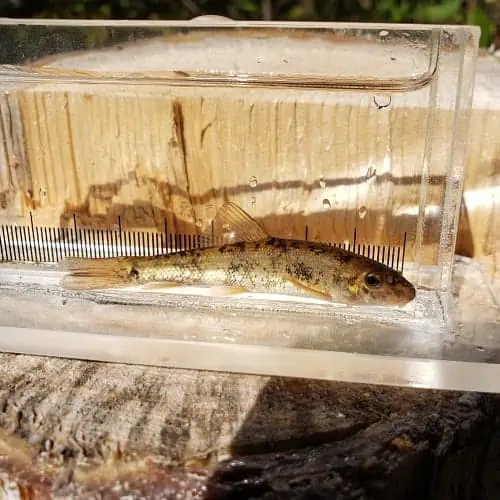
This sucker species can grow much larger than the mountain sucker, commonly reaching lengths of more than 15 inches (38 cm). The white sucker is native to some parts of North America. However, it has been introduced to areas intentionally via bait buckets or unintentionally as a hitchhiker in trout stocking efforts. The white sucker’s introduced range competes with and hybridizes with longnose and mountain suckers. However, they can survive in a broader range of habitat types than the other two species and are far more tolerant to disturbance.
White suckers are safe to eat and provide food for wildlife. Anyone looking to catch white suckers should try for them in rocky pools and large lakes, especially where the water moves quickly. White sucker fry is planktivorous, while older individuals consume invertebrates. It is vital to ensure that live fish are not transported between water bodies as this sucker species readily hybridizes with other suckers and could be problematic for native suckers.
There is no limit on white suckers in New York.
12) Round goby (Neogobius melanostomus)

Round gobies are like darters in appearance, behavior, and ecological niche. As a result, they can quickly fill this niche when introduced to non-native habitats and displace these more sensitive native species. They can be found worldwide and introduced to the Great Lakes region. They usually inhabit the bottom of a water body, predating mollusks, invertebrates, fish, and eggs. This species is aggressive and easily outcompetes or threatens many native species. For example, if a nest is left unguarded by an adult black bass, round gobies will quickly eat the eggs, making them a significant threat to these species.
The round goby is not native to the United States and is one of the many North American Great Lakes invaders. It can be found in the Great Lakes and connected rivers in neighboring states. This species is usually a dull, mottled grey and will grow between 4.3 to 12 inches (11 and 30 cm) in length.
The round goby possesses several traits that give it an advantage over native fish species. For example, they have a robust sensory system that allows them to hunt at night, whereas most North American fish in the same niche hunt during the day. In addition, they tolerate various habitat conditions and have a generalist diet consisting of invertebrates, small fish, and fish eggs. Invasive zebra mussels, which are prolific in the Great Lakes, enhanced the round goby invasion by providing an abundant food source in the Great Lakes.
Possessing round gobies or using them as bait in New York is illegal.
13) Northern pike (Esox lucius)
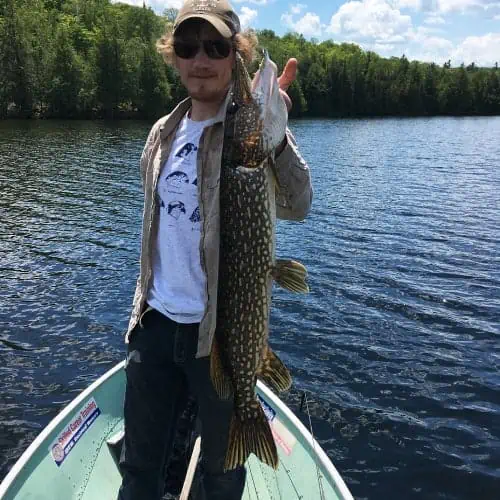
When sport fishers think of a pike, they most often think of the northern pike. This species is an aggressive piscivore and an ambush predator that hides amongst dense vegetation waiting to ambush prey. It is such a voracious predator that it is known to extirpate smaller fish species from isolated lakes and rivers, causing severe problems for conservation. Additionally, the northern pike hybridizes with a native Esox species known as the muskellunge. Female hybrids are fertile and can interbreed with muskellunge populations, gradually replacing the native species with hybrids.
This species is common in lakes and reservoirs and migrates to streams to spawn. Eggs are broadcast over weed beds between March and May. During the breeding season, it is best to target northern pike in streams and shorelines, but they are commonly found near dense, submerged vegetation. They are incredibly aggressive, so care should be taken when handling them. In addition, the northern pike hosts a suite of parasites, some of which can infect humans, so they must be thoroughly cooked before eating.
White or yellow lures work best for northern pike, and anglers can use a variety of bait, including live fish like small sunfish, suckers, or locally available baitfish. The fishing season for the northern pike at Oneida Lake is limited and varies yearly.
The fishing season for northern pike ends in May, and there is a daily five-fish limit.
14) Emerald shiner (Notropis atherinoides)

The emerald shiner is abundant throughout its enormous range. This species is common in large rivers, lakes, and impoundments. Emerald shiners prefer open water because they do not like vegetated areas. They will tolerate some turbidity, although they are more likely to be found in clear streams. They are small, usually around 3.3 in (8.4 cm). Individuals at Oneida Lake may be larger than 4 inches (10 cm). Shiners are a diverse group containing nearly 100 species.
Emerald shiners are important prey species for fish-eating mammals, birds, and fish. They are also used as baitfish by humans. In some regions, they were intentionally stocked to provide forage for predatory sportfish. Emerald shiners consume algae, zooplankton, and small aquatic insects. Spawning occurs from July to August but likely varies throughout its range. They are scatter spawners and do not provide any parental care.
15) American gizzard shad (Dorosoma cepedianum)
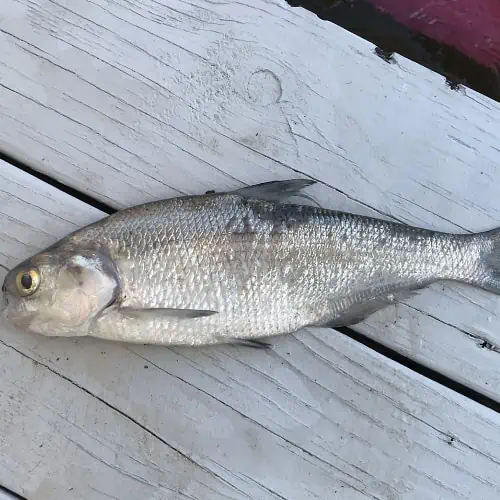
Gizzard shad are generally small, silver fish. On average, they are around 13 inches (33 cm) in length. They are laterally compressed, meaning that they are flattened vertically. Additionally, gizzard shad possess a trailing ray off their dorsal fin. Juveniles have a large black dot near their gill covers that fades as the fish ages. Unlike their close relative, the threadfin shad, the lower jaw of the American gizzard shad does not extend beyond the upper jaw. In addition, American gizzard shad are more tolerant to cold water and are distributed throughout eastern North America.
This species is usually found in freshwater habitats, although some populations are in saltwater and freshwater. For these populations, the shad spends most of their time in the saltwater and migrate to freshwater rivers to spawn.
The breeding season for this species occurs in the spring and summer months. Females mate with multiple males and do not perform any parental care. Due to their abundance and small size, shad are important prey species for larger predatory fish. Juvenile shad are especially important. As juveniles, shad diets consist of zooplankton and filtered organic material.
Up to three shad may be harvested from Oneida Lake per day.
16) Burbot (Lota lota)

The burbot is a species of cod-like fish that is commonly referred to as ling. This fish tends to be long and snake-like with smooth skin and a chin barbel. The average size of a burbot is between 16 and 24 inches (41 – 61 cm). The second dorsal fin and anal fin run almost half the length of its body. While it can live in the ocean, the burbot is remarkable because it is the only cod species that is almost exclusively freshwater.
They prefer cold water, including large rivers and lakes or reservoirs, and are a bit reclusive, hiding amongst rocks and vegetation. Burbots are primarily nocturnal, so a fisherman looking to catch one should aim to do so at night. Young burbot consumes invertebrates, while adults are aggressive carnivores.
Although this fish is not the most popular sport fish, it is still commonly caught and consumed.
17) Coho salmon (Oncorhynchus kisutch)

The coho salmon occupies the same range as the Chinook salmon. However, due to its slightly smaller size, the coho salmon can travel up smaller streams and tributaries during migration events. A typical coho salmon comes in at around 24 to 28 inches (61 to 71 cm) in length, with females being smaller than males. Once they reach sexual maturity, adults migrate back to their natal rivers to spawn. Breeding adults sport a very dark coloration with intense red bellies and blushing on their heads. Males also develop a hooked jaw. This coloration is similar to, although less strong than, that observed in Chinook salmon.
Once hatched, young fish spend at least one winter in freshwater before migrating to the ocean, where they prey upon small fish and insects. While in the sea, most coho salmon spend the next 1 to 4 years eating larger fish species, squid, and prominent individuals who can even hunt birds.
This species is not as common in filet markets as the sockeye or the Chinook, but a substantial community of sport fishers treasures this fish. When harvested commercially, they are usually sold canned or frozen.
The season for coho salmon lasts from April 1st to October 15th, and anglers may harvest up to three individuals per day, provided those individuals are at least 15 inches (38 cm) long.
18) Longnose gar (Lepisosteus osseus)

As its name suggests, the longnose gar possesses a skinny, long snout with rows of sharp teeth. Of all the gar species, the range of the longnose gar extends the farthest north, reaching areas up into Quebec. An average longnose gar will be about 25 inches (64 cm) long.
Longnose gar can be found in slow-moving rivers, ponds, and impoundments, often in small groups. They hover, motionless in the water until a prey item unwittingly approaches them. At this point, they sideswipe the prey item to impale it on their sharp teeth. Longnose gars are vital predators of sunfish, shad, and shiners, controlling prey fish populations. In addition, longnose gar can tolerate higher salinity, sometimes entering saltier waters to hunt menhaden in coastal estuaries.
Populations of longnose gar are of most minor concern and are stable. To fish for longnose gar, one source suggests using minnows and artificial lures.
19) Yellow bullhead (Ameiurus natalis)

With one of the most expansive ranges of any bullhead, the yellow bullhead is one of the most ubiquitous bullhead species in North America, especially in the center of its range. Additionally, it has been introduced to the western United States and some parts of New England. As with the white bullhead, introductions result in reduced biodiversity and have placed pressure on the Chiricahua leopard frog in Arizona. This species looks similar to the white bullhead but is more olive-yellow.
This species can be found in rivers and lakes with calm water and soft substrates like mud, sand, or vegetation. Yellow bullheads are also pollution-tolerant, making them excellent at adapting to human environments. They often hunt for small insects, mollusks, and crustaceans such as clams and crabs. Additionally, adults will consume small fish, frogs, and tadpoles. They are a smaller bullhead species with an average length of 9.8 inches (25 cm).
There is no limit on bullheads in Oneida Lake.
20) Lake sturgeon (Acipenser fulvescens)

At a whopping 8 feet (2.4 m) long and with a maximum weight of 208 pounds (94 kg), the lake sturgeon takes the number one spot as North America’s largest freshwater fish. In addition, they can be incredibly long-lived. One source provides a report of a lake sturgeon over 150 years old. Paddlefish and sturgeon belong to an ancient group of fish whose fossils date back to the Jurassic period. Lake sturgeon have boney scutes and a heterocercal tail, typical characteristics of ancient fish lineages.
Lake sturgeons are demersal, meaning they occupy space in the water column closest to the substrate. They use their barbels to root around in the substrate for food. As a result, their diet is composed of benthic organisms like crayfish and snails.
The IUCN Red List considers sturgeon among the most endangered on Earth. Loss of habitat, particularly spawning grounds, has resulted in a severe reduction in lake sturgeon populations. They were also historically harvested by humans for their caviar. However, in the modern day, the fish is protected, and harvest is illegal in most places. For example, it is unlawful to hunt lake sturgeon in Wisconsin.
Fishing or possessing lake sturgeon in New York is illegal.
21) Satinfin shiner (Cyprinella analostana)

Satinfin shiners are an introduced species of minnow that are not native to Oneida Lake. While the consequences of their introduction are not well understood, they likely interfere with native ecosystems by taking resources from native species in similar niches. They are similar to other minnow species present in the area. The body of a satinfin shiner is entirely silver, and they sometimes possess small dots on their dorsal fins. In addition, the margin of their fins is occasionally white.
This species prefers weed-free areas, so weedy conditions created by another invasive species, the zebra mussel, may be at odds with the preferences of satinfin shiners.
In South Carolina, satinfin shiner populations are decreasing, and therefore this species is protected in that state. However, in New York, there is no limit on satinfin shiners.
22) Shorthead redhorse (Moxostoma macrolepidotum)

Shorthead redhorses are silver members of the sucker family (Catostoidae). Their mouth is turned downwards and their fins have a red tint.
With the old species name Catostomus oneida, the shorthead redhorse is an Oneida native, so much so that it once bore the lake’s name in its species epithet. They are a carp species like the various minnows and shiners in the lake. However, unlike minnows, shorthead redhorses are significant, with a standard length of around 15.7 in (40 cm).
They can be found in large rivers, lakes, and impoundments with spawning territories located over clean gravel. Shorthead redhorses are strict invertivores and consume various insects, crustaceans, and other aquatic invertebrates.
There is no limit on shorthead redhorses in New York.
23) Trout-perch (Percopsis omiscomaycus)

Trout-perch are found in deep parts of lakes and large rivers, preferring areas with sandy substrates. However, they will migrate to streams with gravel or rock substrates to spawn. Trout-perches are named by their shared trout and perch characteristics. However, they are much smaller than trout or perch fish, with an average length of around 3.5 in (8.9 cm).
They are benthic invertivores specializing in submerged aquatic insects, mollusks, and worms near the bottom of the water body. In the spring, trout-perch congregate over gravel substrates to spawn, broadcasting their eggs over the substrate and providing no parental care.
The species is intolerant to pollution and temperature changes. Their resilience has led them to become one of the most abundant fish in the Great Lakes region.

